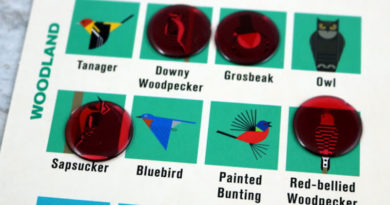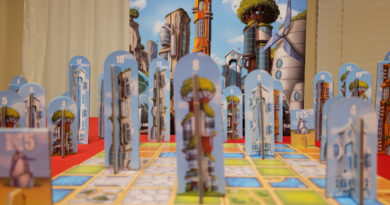Can’t stop playing NMBR 9!
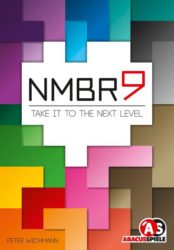
In our home, it’s very rare that one game gets played every day for weeks on end.
But that’s exactly what’s happened this past month since we started playing NMBR 9!
Since we first played NMBR 9 at the start of November, a day hasn’t gone by without someone in our family playing it. Even though I’ve put it back in the game closet when cleaning up a number of times, it shows back up on the kitchen table the next day.
That’s right — it’s not pulled out to play on our game table downstairs, it’s front and center kitchen table play!
Which is also why it gets played multiple times after dinner (and sometimes after breakfast).
And guess who the biggest player of NMBR 9 is?
Mom!
Yep, mom can’t seem to get enough of the game.
And you know when mom loves a game, you’ve got a hit.
I’m pretty sure if we were to update mom’s favorite games list this year, NMBR 9 would come out on top.
It’s almost too bad we didn’t play it before putting together our 2018 Board Game Gift Guide, because it would have certainly topped the list there too. But don’t worry, because you can still get it in time for a Christmas gift for your family!
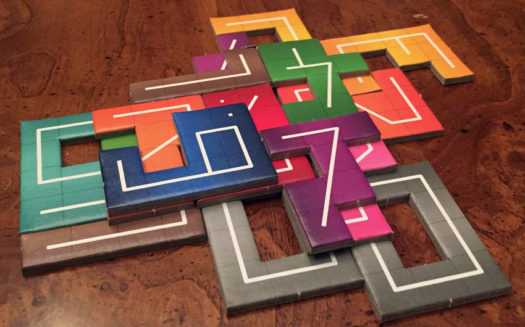
How to play NMBR 9
Perhaps the top 3 reasons NMBR 9 gets played so much in our house is because of how simple the rules are, how quick it is to play, and the puzzley mental challenge it creates.
Since the rules are so simple, it doesn’t take long to explain how to play the game.
In NMBR 9, players stack grid-like numbers (0-9) on top of each other in their own play area to earn the most points. The higher the level a number is on, the more points it will score.
The set up of the game is super simple — you just have to shuffle the number card deck!
That’s it.
To play, flip over the top card of the deck.
Every player takes a tile of the number shown and places it in their own play area according to the placement restrictions:
- The tile can be oriented any way the player likes, but the number side must be faceup.
- The tile must be placed adjacent to a tile on its level. The first tile on a level doesn’t need to follow this rule.
- A tile on a new level must overlap at least 2 tiles on the level below it and every part of the new tile must cover something. There can’t be any overhanging portion.
- Once placed, a tile can’t be moved.
Play continues by drawing cards and placing tiles until the deck is finished. Then players add up their scores.
To score, players multiply their numbers by the level they’re on. The bottom level is Level 0 — so numbers on the base level (Level 0) don’t score any points. Only the numbers from the next level on up will score.
For example, a number 9 on Level 2 will score 18 points.
Players total up the points from each of their numbers placed on Level 1 on up and whoever scores the most points wins!
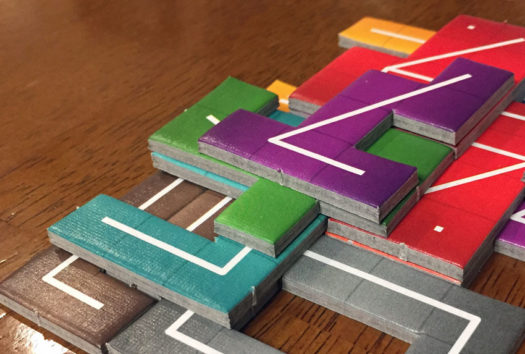
Can the whole family enjoy NMBR 9?
Absolutely!
There’s no question NMBR 9 can be enjoyed by everyone in the family.
Young and old alike can enjoy the simple fun of stacking funky shaped numbers on top of each other. They can all enjoy the challenge of seeing how high of a score they can get.
They’ll also all collectively moan when a 9 or an 8 are drawn first in the game because that means they won’t get to score big from those high numbers because they’ll have to place them on level 0.
It sounds funny to say, but there’s a fun sense of accomplishment when a number is drawn and you have the perfect place for it on level 3. It’s as if your elaborate planning has paid off.
(Although you can’t make elaborate plans because the numbers are randomly drawn. But it’s fun trying to make those plans anyway and feeling happy when something goes your way.)
Since everyone places the same number at the same time, it’s a fun challenge to see if your choices, on where to place your numbers, pay off better than your opponents.
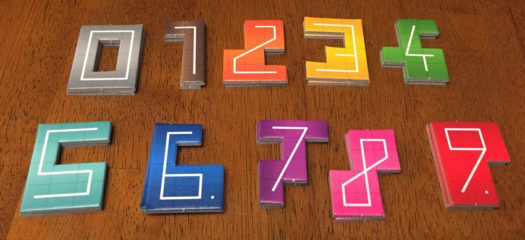
While players can look at each other’s play area, they’ll typically do so more to keep an eye on how the other players are doing rather than to match their placement. They’ll watch to see if the other players are starting to build on higher levels to judge who may be in the lead.
Yet, at the same time, building your levels is a pretty solitary activity. There isn’t any interaction between players.
There isn’t any competition for the number tiles because everyone will get to place 2 of each number before the game ends.
That’s because there are 20 cards in the deck — 2 of each number from 0 to 9. And there are 80 tiles in the game — 8 of each number (2 per player for a full 4-player game).
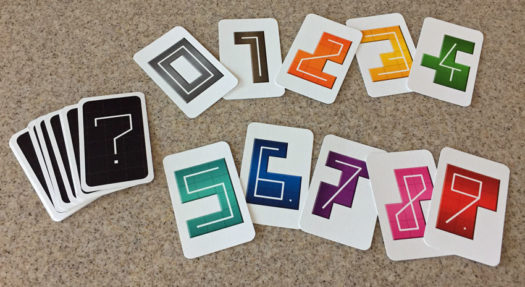
Which also means that it’s a game you can play solo very easily.
And in fact, NMBR 9 has been played many times solo in our family as well.
It’s been fun seeing mom in a break in her day, playing on her own. I’ll come into the kitchen and she’ll be there stacking numbers, trying to get a better score than before.
If you would have told me last month that I might find mom playing a board game on her own, I would have laughed.
But with NMBR 9 I stand corrected. Mom loves it!
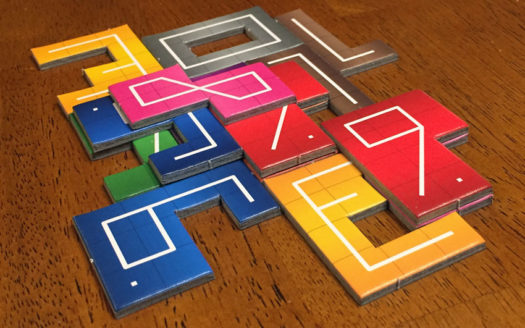
Yet, even though you can play NMBR 9 solo, it’s a lot more fun to challenge others.
You also might think a simple number stacking game doesn’t have much replay value. But if our continual daily plays of NMBR 9 over this last month are any indication, it sure has a lot of replay value in our family.
Perhaps it’s the Tetris-like shaped numbers.
Perhaps it’s because it’s a tile-laying game.
Perhaps it’s because there’s really no set-up needed.
Perhaps it’s because it’s so quick to play a game.
All of those definitely contribute to the repeated plays.
But I believe it’s really the fact that every game is a unique challenge because of the random order in which the numbers are drawn. Since you don’t know which numbers will be drawn next, you can’t perfectly plan your stack.
And it’s that variability, with hope that the perfect number will be drawn next, that keeps us coming back for more.
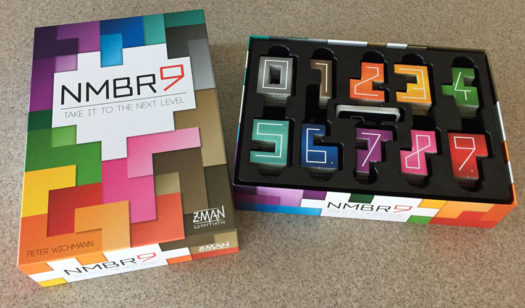
How does NMBR 9 score on our “Let’s Play Again” game meter?
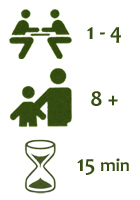 Is there really any question with NMBR 9?
Is there really any question with NMBR 9?
We know we end each of our reviews with this question, so we’ll continue to do so here. But if you can’t tell already, NMBR 9 is off the charts in this regard.
We’ve reviewed over 425 games. And NMBR 9 tops the list for repeated plays in such a short period of time. Yes, it helps that it’s a quick game to play. But as stated above, the game has to be fun at the core to get so many plays in our family.
We have a few strong contenders on our “let’s play again” game meter (Deception, Telestrations, Telepathy, Quarto, City Square Off, Memoir ’44), but NMBR 9 takes the top spot on our “let’s play again” game meter.
If you can’t tell, we highly recommend NMBR 9 for your family!
We’d like to thank Miniature Market for a review copy of NMBR 9.



